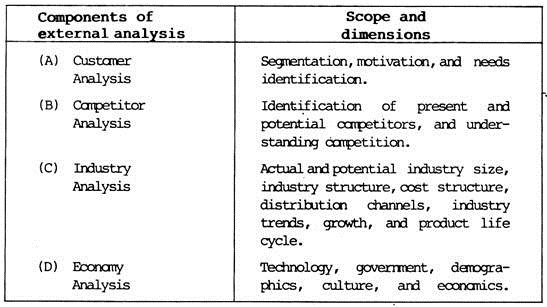External analysis of business is concerned with identifying opportunities and threats and strategic questions that affect key factors of successful performance. Such analysis is necessary for strategy formulation and management in all fields of activity including marketing activity of an organisation. This analysis is mainly concerned with the study of external environment in which a business firm operates.
The components of external environmental analysis can be sunned up in the table below:
Each of the components are discussed below as to their scope and dimensions:
A. Customer Analysis:
It is intended to identify the customer groups, their characteristics and buying motives and so on with a view to ascertaining the customer-oriented product-market scope. This analysis is done along the following dimensions.
(1) Segmentation:
The differences in the responses among the various customer groups in a competitive environment are identified and a programme is made to deliver competitive offers to those identified segments.
The key questions addressed in segmentation are:
(a) Who are the buyers?
(b) Who are the largest buyers?
(c) Who are not buyers now but may buy in future?
(d) How is the market segmented?
(e) How should the market be segmented?
(2) Easterner Motivation:
It involves the identification of factors that direct or motivate the customers to make buying decisions.
The following key questions are addressed:
(a) What are the buying motives?
(b) What are the attributes’ of offer that stimulate the buying
(c) What objectives do the customers seek?
(d) What changes in customer motivation are occurring or likely to occur?
(3) Needs Identification:
The identification of customer needs provides a basis for product development or for a policy to have an edge over competitors.
The following approaches are helpful in this analysis:
(a) Structured interviews to knew the experience of customers with the existing products;
(b) Analysis of the problems or shortcomings associated with the existing products; and
(c) Evaluation of benefits derived and benefits desirable from the existing products.
B. Competitor Analysis:
It is intended to identify the competitors and understand the degree of competition.
The following matters are subjected to closer analysis:
(1) Competitors-Existing and Potential:
(a) Intensity of competition, direct or indirect.
(b) Customer choice between own/competitive products.
(c) Existing and/or substitute products.
(d) Mobility barriers.
(e) Policies of potential competitors as to market expansion, product expansion, exports, etc.
(2) Competition:
(a) Size, growth, profitability.
(b) Current and past strategies with respect to products and markets.
(c) Strengths and weaknesses of competitors.
C. Industry Analysis:
It is conducted for the industry as a whole and for the important product market structure within the industry along the following dimensions:
(1) Actual and Potential Industry Size:
(a) Size of current and potential market.
(b) Gap analysis with respect to usage, distribution, product line, product features, market penetration, etc.
(2) Industry Structure:
(a) Number of existing competitors.
(b) Product differentiation.
(c) Economies of scale
(d) Substitute products.
(e) Capital investment.
(3) Cost Structure:
(a) Plant capacity.
(b) Fixed assets investment.
(c) Working capital employed.
(d) R O I.
(4) Distribution Channels:
(a) Branches and depots.
(b) Showrooms.
(c) Wholesalers’ and retailers’ relative importance.
(5) Industry Trends:
(a) Averages and norms typical of the industry.
(b) History of innovation.
(c) Technological trends.
(d) Role of technology in success.
(e) New products.
(f) Profitability.
(6) Growth and Product Life Cycle:
(a) Profits and profitability.
(b) New growth directions.
(c) Additions to the existing product lines.
(d) Basic determinants of demand.
(e) Market share, concentration, segmentation, dominance.
(f) Relation to life cycle of the product and present stage.
(g) Technology status.
D. Economy Analysis:
(1) Technology:
(a) Maturity of old technologies, and
(b) New technologies.
(2) Government:
(a) Regulations,
(b) Tax policies,
(c) Stability, and
(d) Industrial policies.
(3) Culture:
(a) Life style,
(b) Fashions,
(c) Opinions,
(d) Education and
(e) Social upliftment.
(4) Demographics:
(a) Age,
(b) Income,
(c) Family, and
(d) Geographic location.
(5) Economics:
(a) National and international economic trends,
(b) Economic health of industries,
(c) Interest rates,
(d) Currency valuation.
